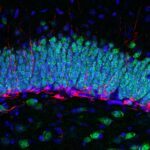Lien vers Pubmed [PMID] – 28902836
Nature 2017 Sep;549(7672):384-388
Long-term potentiation (LTP) of excitatory synaptic transmission has long been considered a cellular correlate for learning and memory. Early LTP (less than 1 h) had initially been explained either by presynaptic increases in glutamate release or by direct modification of postsynaptic AMPA (α-amino-3-hydroxy-5-methyl-4-isoxazolepropionic acid) receptor function. Compelling models have more recently proposed that synaptic potentiation can occur by the recruitment of additional postsynaptic AMPA receptors (AMPARs), sourced either from an intracellular reserve pool by exocytosis or from nearby extra-synaptic receptors pre-existing on the neuronal surface. However, the exact mechanism through which synapses can rapidly recruit new AMPARs during early LTP remains unknown. In particular, direct evidence for a pivotal role of AMPAR surface diffusion as a trafficking mechanism in synaptic plasticity is still lacking. Here, using AMPAR immobilization approaches, we show that interfering with AMPAR surface diffusion markedly impairs synaptic potentiation of Schaffer collaterals and commissural inputs to the CA1 area of the mouse hippocampus in cultured slices, acute slices and in vivo. Our data also identify distinct contributions of various AMPAR trafficking routes to the temporal profile of synaptic potentiation. In addition, AMPAR immobilization in vivo in the dorsal hippocampus inhibited fear conditioning, indicating that AMPAR diffusion is important for the early phase of contextual learning. Therefore, our results provide a direct demonstration that the recruitment of new receptors to synapses by surface diffusion is a critical mechanism for the expression of LTP and hippocampal learning. Since AMPAR surface diffusion is dictated by weak Brownian forces that are readily perturbed by protein-protein interactions, we anticipate that this fundamental trafficking mechanism will be a key target for modulating synaptic potentiation and learning.

